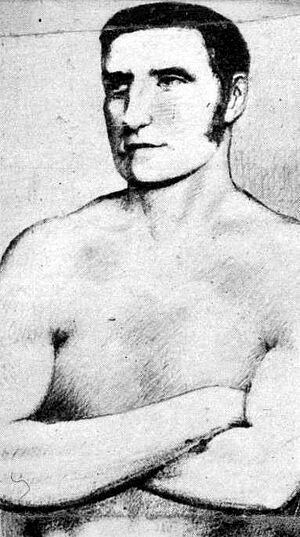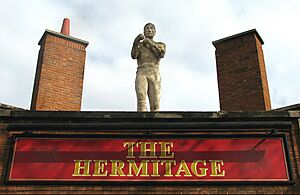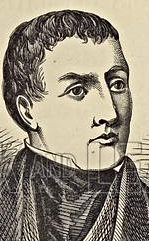William Thompson (boxer) facts for kids
Quick facts for kids William Thompson |
|
|---|---|
 |
|
| Statistics | |
| Nickname(s) | Bendigo, Bendego (in period newspapers) |
| Rated at | averaged 165 lb (75 kg), weight range 164 to 168 pounds (74–76 kg) |
| Height | 5 ft 9.75 in (1.77 m) |
| Born | 11 October 1811 Trinity Walk, Nottingham, England |
| Died | 23 August 1880 (aged 68) Beeston, Nottinghamshire, England |
| Stance | Southpaw Used London Prize Ring Rules after 1838 |
| Boxing record | |
| Total fights | 20 |
| Wins | 19 |
William Abednego Thompson (11 October 1811 – 23 August 1880), also known Bendigo Thompson, was an English bare-knuckle boxer who won the heavyweight championship of England from James Burke on 12 February 1839. He was inducted into The Ring magazine Hall of Fame in 1955, the International Boxing Hall of Fame in 1991, and the Bare Knuckle Boxing Hall of Fame in 2011. His nickname of "Bendigo" lives on in the name of a city and creek in Australia.
Contents
Early life
Born in New Yard, now Trinity Walk, Nottingham on 11 October 1811, Thompson claimed to be one of a set of triplets named Shadrach, Meshach, and Abednego, after the young men in the Book of Daniel who are thrown into the fiery furnace of Babylon. However, he was baptised at St Mary's Church, Nottingham on 16 October 1811 with his twin brother Richard. Richard died and was buried at the same church on 25 October 1811. If he was one of triplets, then the third must have died at, or soon after, birth.
It has often been claimed that Thompson was the youngest of a struggling family of twenty-one children born to Benjamin Thompson, a mechanic in the lace industry, and his wife Mary, in the slums of Nottingham. However, that is a myth. William was one of six children (possibly seven) and had a younger sister, Mary, who died at the age of four. The eldest child in the family, Rebecca, born 1805, remains a mystery, because further details of her life cannot be found, and William grew up with just two surviving brothers, Thomas and John. William Thompson was strong and well developed as a young man and performed, demonstrating natural ability in various sports. His father died when he was only fifteen and, accompanied by his mother, he was sent to the Nottingham Workhouse. After leaving the Workhouse, Thompson sold oysters on the streets of Nottingham before landing a position as an iron turner, a job that enhanced his muscular build.
By the age of 18, Thompson began fighting to provide for his family. He defeated his first eight opponents, including the champion of the nearby town of Bingham. By the age of 21, he became a professional prize fighter and the details of his contests began to be recorded. Thompson was a southpaw and once, on a bet, he is said to have thrown half a house brick over the River Trent with his left hand. Although being barely 177 cm (5 ft 10 in) tall, he compensated for his lack of height with an incredible ability to punch hard and fast, and was said to be devoid of fear. He was also very agile, earning the name "Bendy" because of his constant bobbing and weaving around the ring. His nickname evolved and "Bendy", in combination with his name Abednego, became "Bendigo".
Though it was his speed and agility that won him his fights, it was Thompson's personality and sense of humour which endeared him to the crowd.
First bout against Ben Caunt
Thompson's career was punctuated by his fierce rivalry with the Hucknall-born boxer Ben Caunt. On 21 July 1835, the two first met to split a purse of £25. This fight lasted 35 minutes, with 22 rounds, each round being called when either boxer's knee touched the ground. In the last round, Caunt struck Thompson while he was sitting on his second's knee in his corner, costing Caunt the match on a foul.
Over the next two years, Thompson fought three bouts, first dispatching the renowned John Leachman of Bradford in a 52-round contest, before moving to Newcastle the following year to defeat Charley Langham in 51 rounds.
A few months later, Thompson responded to a letter in a newspaper from Liverpudlian William Looney, challenging "... any man in the world for £200 stake and £200 a-side". The two met on 13 June 1838, on a hill known as Chapel-en-le-Frith, the halfway point between their home towns. The fight lasted for 92 rounds. Eventually Thompson's athleticism shone through and he was declared the winner after dominating over an hour of fighting.
Fame
First title bout with Caunt, 1838
Thompson's star rose steadily. On 3 April 1838, before a crowd of 5,000, Caunt finally obtained his rematch at Skipworth Common, worth £300 in prize money. Although younger by three years, Caunt came into the ring in poorer condition than Thompson, who had trained hard prior to the match. Thompson's superior conditioning gave him greater speed and agility, and better defensive skills. The fight lasted for 75 rounds of furious combat. In the seventy-fifth round, the referee stopped the fight, because Thompson had fallen to the ground without being struck, an illegal tactic according to London Prize Ring Rules. After the fight, Thompson claimed it was a slip, a claim backed up by contemporary accounts, putting him well ahead and coasting. After the referee called the foul against Thompson, pandemonium broke out. His supporters attacked Caunt. Caunt was dragged to his coach by his seconds and attempted to flee. The coach was arrested by Thompson's mob who dragged Caunt out, but he escaped.
Champion of England, 1839
On 8 February 1839, when Thompson was 28, he was given the task of defeating the fearsome Londoner James "Deaf" Burke for the All England Title and a purse of £220. The fight was one of the first Thompson fought under the new London Prize Ring Rules. It lasted just ten rounds. Burke lost on a foul and gifted the championship away. The "Nottingham Jester", Champion Prize Fighter Of All England was presented his Champion's Belt a few weeks later at a ceremony in The Queens Theatre, Liverpool. When he got home to Nottingham, Thompson met his supporters on 23 March 1840, and in his excitement while somersaulting he hurt his kneecap and was laid up for two years. Thompson never stepped down from a challenge, and once he recovered from his knee injury he defeated 19 opponents over the next 4 years, including 7 in one month.
Defending the title against Caunt, 1845
On 9 September 1845 at Lillington Level, Suffield Green, Oxford, a crowd of 11,000 came to see the third and final fight between Thompson and Caunt who would settle the score for 200 a side. Thompson's tactics were called into question as he crouched and bobbed his way around the ring, making it harder for Caunt to hit him. Hardly a round went by without a foul being claimed in a notoriously dirty grudge match. The fight lasted a lengthy 93 rounds until, exhausted after two hours ten minutes, Caunt sat down with his back turned on his "nether end" without getting hit, losing on a foul. Thompson would be declared the winner on a foul despite Caunt's advantage in height, weight, and youth. The fight was described by a contemporary writer as "one of the most scandalous brawls in boxing history. Both men used every foul under the sun and invented a good many others ..." Bells Life wrote that Thompson's methods were opposed to the principles of a fair, stand-up fight, and were the actions of a coward.
This fight seemed to have taken a lot out of Thompson, who went back to his childhood pastime of fishing. He became very friendly with a well-known angler called William Bailey, who made and sold fishing tackle from his shop in Broadmarsh. Thompson won several All England fishing awards.
Last title bout with Tom Paddock, 1850
Although enjoying his quiet life, Thompson accepted a challenge from young Tom Paddock from Redditch and, on 5 June 1850, the 39-year-old William Abednego Thompson began his last fight. In two minds as to whether to accept the challenge or not, his 82-year-old mother encouraged him by saying "And I tell you this Bendy, if you don't take up the challenge you are a coward. And I tell you more, if you won't fight him I'll send and take up his challenge myself."
The fight was a close one and lasted over an hour. In what became the last round, Thompson's corner man called foul and the referee concurred, giving Thompson the decision.
Retirement and decline
Feeling he was getting too old for prize fighting, Thompson, "The Nottingham Jester", stepped down undefeated as champion, with two prize belts and four silver cups to his name. His outspoken character and record in the ring attracted a massive fan base, including Sir Arthur Conan Doyle.
Speaking about his own career, Thompson said proudly: "I was engaged in 21 matched fights and never was beaten in one." After declaring his retirement, he took up an unofficial role as boxing coach at Oxford University, teaching the art of pugilism. Because it was an unofficial role, the staff described him as a professor, to avoid suspicion and hide his lower-class origins. That job was a step up from his impoverished life in the Nottingham work house.
His association with the upper classes wasn't entirely to his liking, and he soon made his way back to Nottingham. Not long after his return, his mother died. Thompson was now a national celebrity and comparatively wealthy. He became involved with the Nottingham Lambs, a politically motivated group which was active in Nottingham, causing much civil unrest and violence. On some occasions they rioted through the Market Square, protesting against the conditions in which people were forced to live, and burning down Nottingham Castle.
Later life
He eventually moved to Beeston. Once, at the age of 59, he dived into the river to save three people who appeared to be drowning. When a woman he had rescued offered him a reward, he rejected her offer with scorn, reminding her that he was the champion of England.
In 1872, Thompson attended a congregation led by preacher Richard Weaver. Though Thompson was illiterate, he delivered a strong and convincing sermon. When preaching at the Ebenezer Lodge of Good Templars, he would take up a boxer's stance, turn to his trophies and say, "See them belts? See them cups? I used to fight for those, but now I fight for Christ."
His popularity as a fighter soon brought enormous crowds to his sermons with scores left outside. Thompson spent the next few years touring the country preaching to crowds of thousands, becoming more popular, and eventually he gained attention of politicians. Some in the public sector noted, "that although he couldn't read the bible, his straightforward manly speech could be useful".
Thompson died on 23 August 1880, aged 68, after falling down the stairs of his home in Beeston. His funeral procession was exceedingly long and was watched by thousands lining the roads, including a number of the wealthy and famed. Impressively, The Times of London published an obituary, usually an honour bestowed only on the most famous Britons. He was buried on 27 August 1880 in St Mary's burial ground, Sneinton, Nottingham. Thompson's tomb, which features a crouching lion, can be seen at the burial ground in Bath Street Rest Gardens, near Victoria Leisure Centre in Nottingham.
Selected fights
| 5 Wins, 1 Loss | |||||||
| Result | Opponent(s) | Date | Location | Duration | Notes | ||
| Win | Joe Hanley | Oct 1832 | England | 16 rounds | |||
| Win | Ben Caunt | 21 June 1835 | Nottingham England | 22 Rounds | Won on a foul, Caunt struck Thompson when he was down | ||
| Win | Bill Looney | 13 June 1837 | Chapel-en-le-Firth, England | 99 Rounds | |||
| Loss | Ben Caunt | 3 April 1838 | Shelby, England | 75 rounds | Lost on foul | ||
| Win | James Burke | 12 February 1839 | Heather, England | 10 rounds | Won Championship of England, on foul | ||
| Win | Ben Caunt | 9 September 1845 | Stoney Stratford, England | 75 rounds | Defended English Championship, won on foul | ||
| Win | Ben Caunt | 5 June 1850 | Mildenhall, England | 75 rounds | Retained English Champion, won on foul, then retired | ||
Legacy

A public house in Sneinton, Nottingham was named after its famous resident. The Old Wrestlers pub was converted to Bendigo's in 1957 and became popular among Sneinton locals. Ironically the pub was forced to close in the late 1990s due to brawling but re-opened as The Hermitage in 1999 and remained in operation for another decade before closing again in 2009. As of 2013, the building has been renovated and is used for private events, although the statue of Thompson above the entrance still remains and locals commonly refer to the site as Bendigo`s or The Bendigo to this day.
The area of Sneinton just north east of the pub falls within the Nottinghamshire Police beat called Bendigo. This covers the area from Kentwood Rd north east to Highcliffe Rd and part of Colwick Wood, including the north part of Racecourse Rd (opposite the entrance to Nottingham racecourse). Just off this road is a small new-build housing area, the main road being Bendigo Lane.
One of the trams operated by Nottingham Express Transit carries the name of Bendigo Thompson.
The city of Bendigo in Victoria, Australia is indirectly named after Thompson. An early Australian shepherd on the Ravenswood Run was also a bare-knuckle boxer with a style reminiscent of Thompson, and hence was given the same nickname, which was then applied to the area as Bendigo's Creek. The town that grew up around the area in the 19th century was named as Sandhurst but reverted to Bendigo in 1891.
In Bestwood, a suburban part of Nottingham, there is a small nature reserve on Sunrise Hill that was a copse known locally as "Bendigo's Ring". The name is now mistakenly associated with nearby Glade Hill which still carries a highly visible copse.
A character named Gonolph Bendigo, clearly meant to be analogous to William Thompson, appeared in the second series of Defoe, a comic anthologised in 2000AD. Although Defoe is set in the seventeenth, rather than nineteenth, century, the character owes a lot to the real-life boxer, being a retired bare-knuckle fighter of note whose nickname was also "Bendy" and who famously defeated a Ben Caunt.
A Nottingham-based group called the 'Bendigo Memorial Fund' are raising money to have a statue of Bendigo in Nottingham city centre.
Southpaw stance
Thompson is often credited with introducing the southpaw stance.



